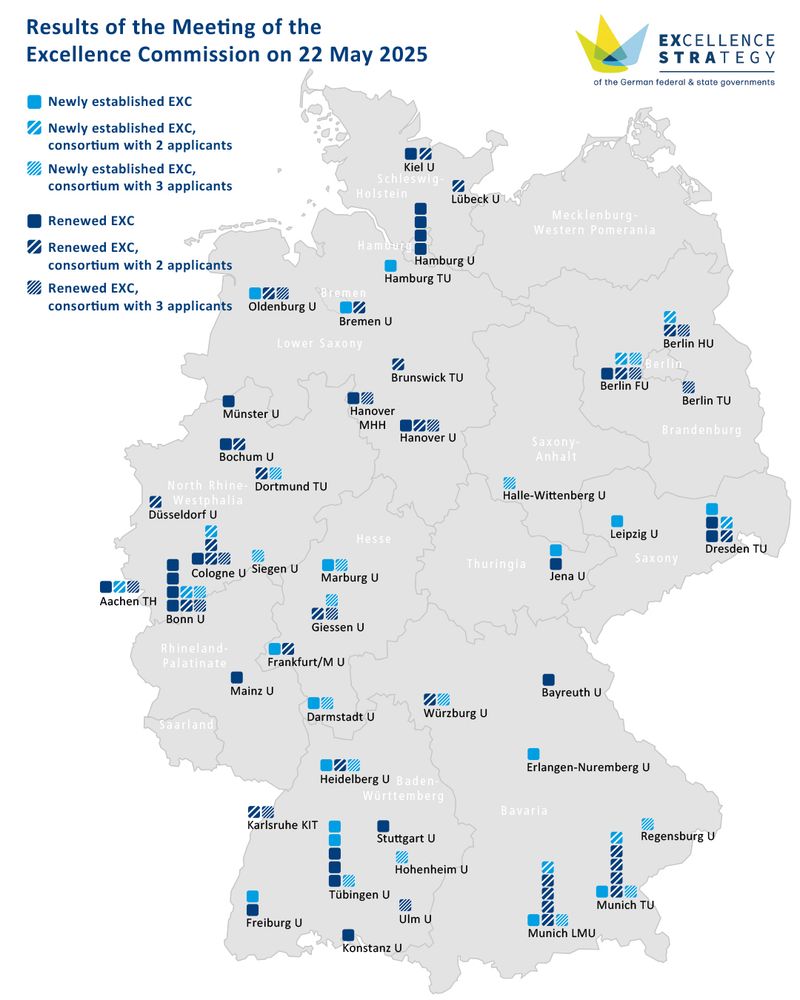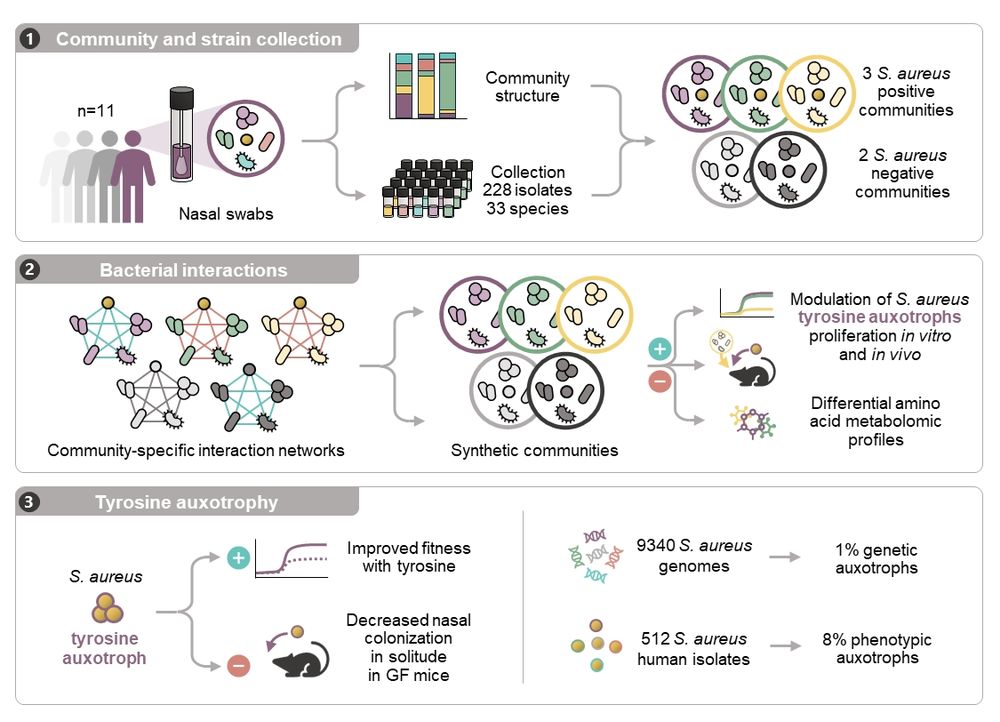@simonheilbronner.bsky.social
Prof. at the LMU Munich. Interested in S. aureus and the nasal microbiome.
Reposted
Yeah! 7 more years for @cmfi.bsky.social
So many people to thank... We are a fantastic team!
So many people to thank... We are a fantastic team!
🎉 Fantastic News 🎉
Our CMFI Cluster of Excellence @unituebingen.bsky.social receives funding extension for the next seven years.
Spokesperson Andreas Peschel @andreaspeschel.bsky.social: "We can now advance our research into resistance mechanisms and new antimicrobial agents!"
shorturl.at/rcK1A
Our CMFI Cluster of Excellence @unituebingen.bsky.social receives funding extension for the next seven years.
Spokesperson Andreas Peschel @andreaspeschel.bsky.social: "We can now advance our research into resistance mechanisms and new antimicrobial agents!"
shorturl.at/rcK1A
CMFI Enters Second Funding Period | CMFI News
The members of CMFI can breathe a sigh of relief: On January 1, 2026, the Tübingen Cluster of Excellence will enter its second funding period with a duration of seven years. This was announced by the ...
www.cmfi.uni-tuebingen.de
May 22, 2025 at 4:40 PM
Yeah! 7 more years for @cmfi.bsky.social
So many people to thank... We are a fantastic team!
So many people to thank... We are a fantastic team!
Reposted
Die Universität Tübingen erhält sechs #Exzellenzcluster, die im Rahmen der #Exzellenzstrategie vom 01.01.2026 an sieben Jahre lang gefördert werden! Darunter drei Cluster, die bereits etabliert sind und eine erneute Förderung erhalten. uni-tuebingen.de/universitaet... #ExStra #Forschung #UniTübingen

May 22, 2025 at 5:13 PM
Die Universität Tübingen erhält sechs #Exzellenzcluster, die im Rahmen der #Exzellenzstrategie vom 01.01.2026 an sieben Jahre lang gefördert werden! Darunter drei Cluster, die bereits etabliert sind und eine erneute Förderung erhalten. uni-tuebingen.de/universitaet... #ExStra #Forschung #UniTübingen
Reposted
The #ClustersOfExcellence have been selected: today, the Excellence Commission approved 70 projects for funding. 45 clusters will continue and 25 will be newly established. Funding starts on 1 Jan 2026 for 7 years, with €539 million per year. The full list: www.dfg.de/resource/blo... 1/3

May 22, 2025 at 6:10 PM
The #ClustersOfExcellence have been selected: today, the Excellence Commission approved 70 projects for funding. 45 clusters will continue and 25 will be newly established. Funding starts on 1 Jan 2026 for 7 years, with €539 million per year. The full list: www.dfg.de/resource/blo... 1/3
Reposted
Join us in Tubingen as a Junior Research Group Leader if you do research on #ESKAPE pathogens and infections and are interested in the highly cooperative environment of @dzif.bsky.social and @cmfi.bsky.social ! Please send your application or forward to colleagues!
uni-tuebingen.de/universitaet...
uni-tuebingen.de/universitaet...

May 19, 2025 at 9:18 AM
Join us in Tubingen as a Junior Research Group Leader if you do research on #ESKAPE pathogens and infections and are interested in the highly cooperative environment of @dzif.bsky.social and @cmfi.bsky.social ! Please send your application or forward to colleagues!
uni-tuebingen.de/universitaet...
uni-tuebingen.de/universitaet...
I am happy to share our latest preprint, spearheaded by Laura Camus. We show that tyrosin-dependent interactions can foster integration of S. aureus into the nasal microbiome. @cmfi.bsky.social @lmumuenchen.bsky.social
www.biorxiv.org/content/10.1...
www.biorxiv.org/content/10.1...

May 7, 2025 at 11:16 AM
I am happy to share our latest preprint, spearheaded by Laura Camus. We show that tyrosin-dependent interactions can foster integration of S. aureus into the nasal microbiome. @cmfi.bsky.social @lmumuenchen.bsky.social
www.biorxiv.org/content/10.1...
www.biorxiv.org/content/10.1...
Reposted
Matching phages to cognate host bacteria has remained merely empirical. We describe a new tool predicting the host range of #S.aureus-specific phages, based on phage receptor binding protein sequences, which will become helpful for #phage-therapy.
www.sciencedirect.com/science/arti...
www.sciencedirect.com/science/arti...

Characterization and host range prediction of Staphylococcus aureus phages through receptor-binding protein analysis
Bacteriophages are crucial in bacterial communities and can be used for therapy of multidrug-resistant pathogens such as Staphylococcus aureus. Howeve…
www.sciencedirect.com
March 3, 2025 at 10:00 AM
Matching phages to cognate host bacteria has remained merely empirical. We describe a new tool predicting the host range of #S.aureus-specific phages, based on phage receptor binding protein sequences, which will become helpful for #phage-therapy.
www.sciencedirect.com/science/arti...
www.sciencedirect.com/science/arti...
Reposted
We derive iron-siderophore interaction networks among Pseudomonas strains from sequencing data. One key insight: natural strains form dense networks, whereas pathogens are loners. With @frimanscience.bsky.social @zhiyuanli.bsky.social & Nanjing colleagues
www.science.org/doi/10.1126/...
www.science.org/doi/10.1126/...

Siderophore synthetase-receptor gene coevolution reveals habitat- and pathogen-specific bacterial iron interaction networks
Coevolving siderophore genes shape bacterial iron networks, unveiling the complexity of cheating across habitats and lifestyles.
www.science.org
January 16, 2025 at 9:29 AM
We derive iron-siderophore interaction networks among Pseudomonas strains from sequencing data. One key insight: natural strains form dense networks, whereas pathogens are loners. With @frimanscience.bsky.social @zhiyuanli.bsky.social & Nanjing colleagues
www.science.org/doi/10.1126/...
www.science.org/doi/10.1126/...
Reposted
Whow so interesting
A novel polysaccharide in the envelope of S. aureus influences the septal secretionof preproteins with a YSIRK/GXXS motif 🦠🧫🧪
journals.asm.org/doi/10.1128/...
journals.asm.org/doi/10.1128/...

A novel polysaccharide in the envelope of S. aureus influences the septal secretion of preproteins with a YSIRK/GXXS motif | Journal of Bacteriology
Gram-positive bacteria assemble peptidoglycan-linked polymers known as wall teichoic
acids (WTA). Both Staphylococcus aureus and Bacillus subtilis elaborate WTAs made of poly-glycerol or poly-ribitol ...
journals.asm.org
January 29, 2025 at 7:16 PM
Whow so interesting

